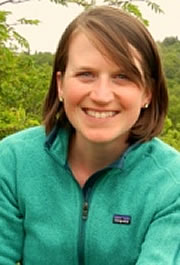Out for a walk
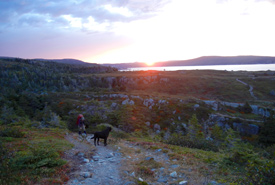
Approaching the Bay Bulls lighthouse with the last of the daylight (Photo by Lanna Campbell/NCC)
An unnatural thirst for physical pain and the lure of making memories set the stage as we carefully planned out nine days’ worth of trail food. My tent-mate, Megan, would later ask me a few days in, “Did I want to do this hike, or did I want to have done it?”
I’m not quite sure where the inspiration came from for this adventure. Maybe it was because we knew a friend who had done it, and we found ourselves devouring her every trail story. Or maybe it was the fact that two other friends mentioned wanting to give it a go, and the timing felt ripe for the picking.
Our plan: we would hike the East Coast Trail (ECT), starting in Cappahayden, Newfoundland and Labrador, and walk north toward St. John’s, as far as we could go.
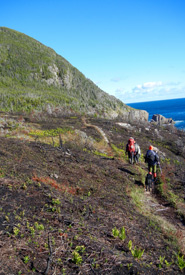
Approaching Cape Broyle, one of the East Coast Trail’s toughest trails (Photo by Lanna Campbell/NCC)
The ECT is a wilderness hiking trail on the Island of Newfoundland. Created 22 years ago, the ECT was based on a vision to re-open the traditional trails and rights-of-way that linked communities along the east coast of the Avalon Peninsula. A total of 265 kilometres of developed trail connects 23 coastal communities. I can now attest most of that is not flat.
When we are dropped off at the trail head on night number one, I remember feeling an indescribable queasiness. We were a two-hour drive from St. John’s and our backpacks were engorged and our feet innocently tender. My black Labrador, Polly, unassumingly jumped out of the car with boundless energy. We clamoured a few hundred metres into the trail to set up camp before dark, a fiery sunset as our backdrop.
I remember the Atlantic Ocean roaring so loudly I thought it would wash into the tent. As I struggled to share my tent mattress with Polly, I lay there reassuring myself this would be fun.
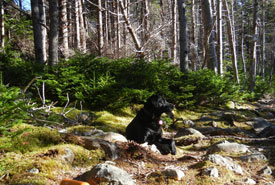
Polly rests while her fellow hiking companions filter water (Photo by Lanna Campbell/NCC)
Day one was a memorable 20 kilometres of trail I feel comfortable saying I never have to hike again. Equipped with what was clean, dry gear, we trudged through what felt like an uphill wetland, with a quiet resolve to not lose our minds. I fell into a creek towards the end of the day, quickly scrambling up to save the contents of my pack. I remember thinking to myself: this is only the beginning.
The eight days that followed took on a somewhat peaceful, methodological rhythm. We went to bed with the sun, crawling into our sleeping bags to soothe our sorry feet before 8:00 p.m. The morning was a time to carefully construct the steps required from being warm and horizontal, to wearing your boots with your pack pressed into the sores of your shoulders. An October frost coated the tent, yesterday’s moisture still in our socks, and we took longer than usual to linger over our morning tea.
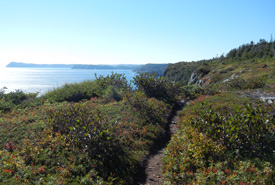
Looking south at how far we've come (Photo by Lanna Campbell/NCC)
It became very clear that we would all be driven by a strong wilfulness to move forward, upward and onward. Polly seized every opportunity to nap, as we filtered water, demolished lunch and set up camp. As we walked we botanized; listing native flora and dodging moose scat. On our right, the ominous ocean, its hypnotic motion providing a rolling soundtrack. The coastal forest looking as weathered as us; tangled, crooked and (almost) blown over.
Despite October serving us up incredible weather, we met only a handful of fellow hikers. We walked through communities both booming and abandoned, routinely coming across hints of where people used to live and places where people still return to hunt, cut wood or fish.
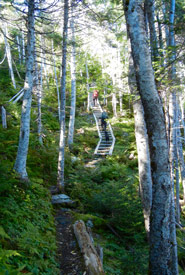
Gaining elevation on the ECT (Photo by Lanna Campbell/NCC)
It is safe to say that by day nine we were a beautiful blend of mixed emotions, much like the salad in a bag from the local grocery store we all devoured at the trail head of the last path. There was an eagerness to finish our quest; to have a hot shower, go barefoot, and for me, embrace my toddler.
It’s amusing how quickly the mind replaces the bad with the good. When I think about our trek now, I remember drinking morning tea while gannets dive-bombed for fish in the ocean in front of us, or looking up to see a narrow footpath carved out of a vibrantly coloured coastal bog waiting for me to walk it, or shouting out, "love you!" to my fellow hikers before falling asleep. Time spent in nature does that to you. It envelops you, puts your heart on your sleeve and makes wet socks irrelevant.
In the end we hiked 150 kilometres, ending just a short distance from our warm beds in St. John’s. It was nothing big, but it was still pretty memorable.

